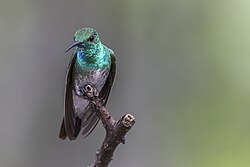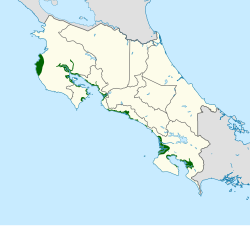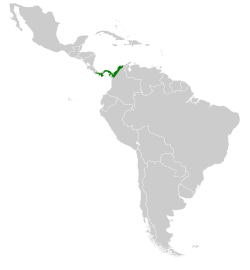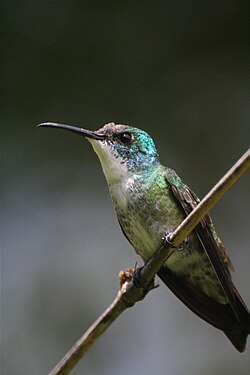| Common name | Scientific name and subspecies | Range | Size and ecology | IUCN status and estimated population |
|---|
| Shining-green hummingbird 
Male

Female | Chrysuronia goudoti
(Bourcier, 1843)
| Colombia and Venezuela
 | Size:
Habitat:
Diet: | LC
|
|---|
| Golden-tailed sapphire 
Male

Female | Chrysuronia oenone
(Lesson, R, 1832) | Bolivia, Brazil, Colombia, Ecuador, Peru, and Venezuela
 | Size:
Habitat:
Diet: | LC
|
|---|
| Versicolored emerald 
Male
| Chrysuronia versicolor
(Vieillot, 1818) | northern Bolivia, eastern Paraguay, far north-eastern Argentina, and eastern, southern and central Brazil
 | Size:
Habitat:
Diet: | EN
|
|---|
| Mangrove hummingbird  | Chrysuronia boucardi
(Mulsant, 1877) | Costa Rica.
 | Size:
Habitat:
Diet: | LC
|
|---|
| Sapphire-throated hummingbird 
Male
| Chrysuronia coeruleogularis
(Gould, 1851)
- C. c. coeruleogularis
- C. c. coelina
- C. c. conifis
| Panama, Colombia, and more recently Costa Rica
 | Size:
Habitat:
Diet: | LC
|
|---|
| Sapphire-bellied hummingbird
| Chrysuronia lilliae
(Stone, 1917) | Colombia
 | Size:
Habitat:
Diet: | EN
|
|---|
| Humboldt's sapphire  | Chrysuronia humboldtii
(Bourcier & Mulsant, 1852) | Colombia, Ecuador, and Panama
 | Size:
Habitat:
Diet: | LC
|
|---|
| Blue-headed sapphire  | Chrysuronia grayi
(Delattre & Bourcier, 1846) | Colombia and Ecuador.
 | Size:
Habitat:
Diet: | LC
|
|---|
| White-chested emerald  | Chrysuronia brevirostris
(Lesson, R, 1829)
- C. b. brevirostris
- C. b. chionopectus
- C. b. orienticola
| Brazil, the Guianas, Trinidad, and Venezuela.
 | Size:
Habitat:
Diet: | LC
|
|---|
| Plain-bellied emerald  | Chrysuronia leucogaster
(Gmelin, JF, 1788)
- C. l. leucogaster(Gmelin, JF, 1788)
- C. l. bahiae(Hartert, E, 1899)
| Brazil, the Guianas, and Venezuela.
 | Size:
Habitat:
Diet: | LC
|
|---|




























